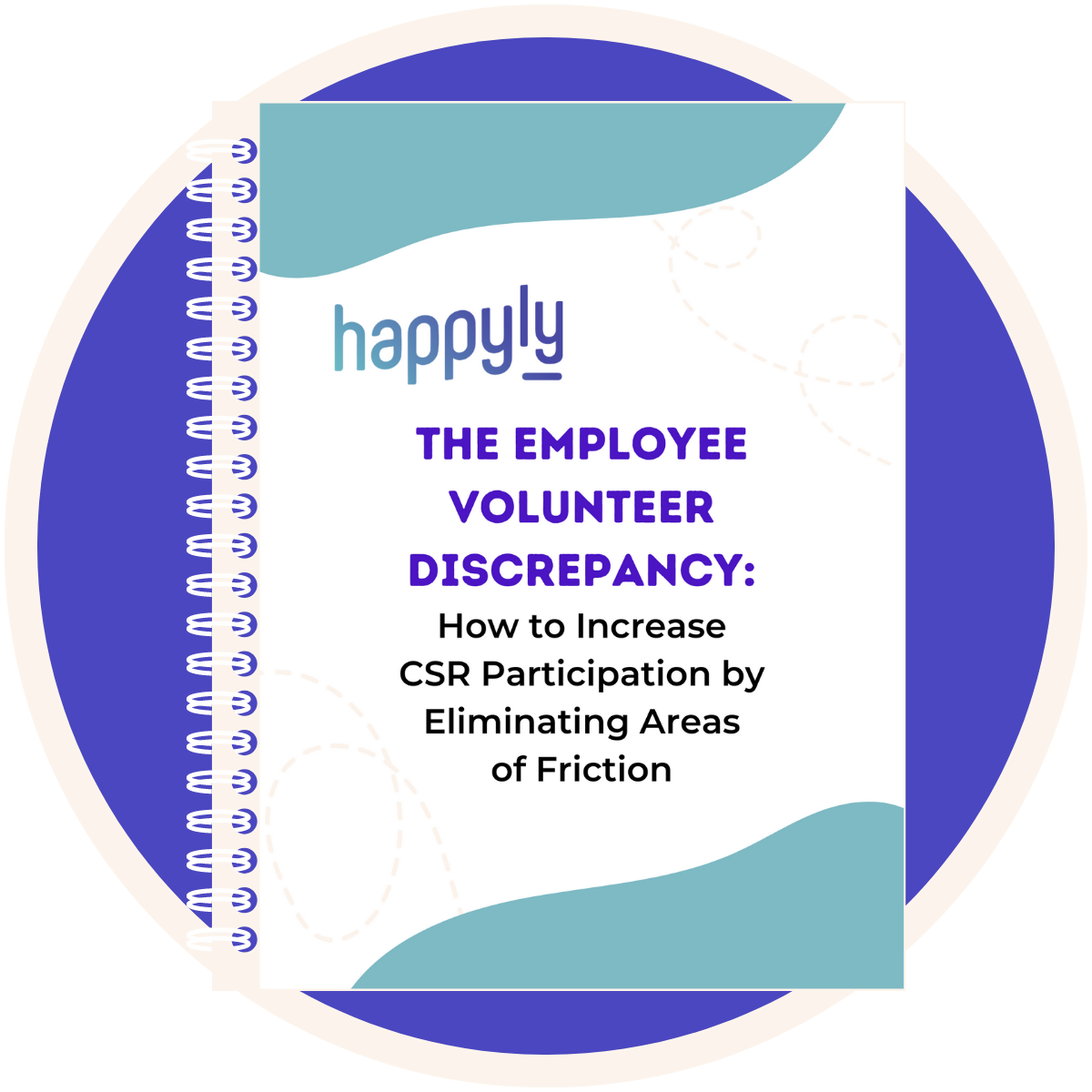The Employee Volunteer Discrepancy
How to Increase CSR Participation by Eliminating Areas of Friction
A Volunteer Discrepancy
In our current Corporate Social Responsibility (CSR) landscape, there’s a troubling discrepancy. As employers increasingly recognize the far-reaching benefits of giving back, companies are offering more paid volunteer hours and company-wide giveback opportunities than ever before. Paid time off for volunteering is one of the few employee benefits that increased significantly in recent years,1 with 89% of companies reporting the presence of an employee volunteer program.2 But in spite of these comprehensive offerings and their established benefits, employee volunteer programs are being categorically underutilized. The average employee volunteer participation rate is 17%.3
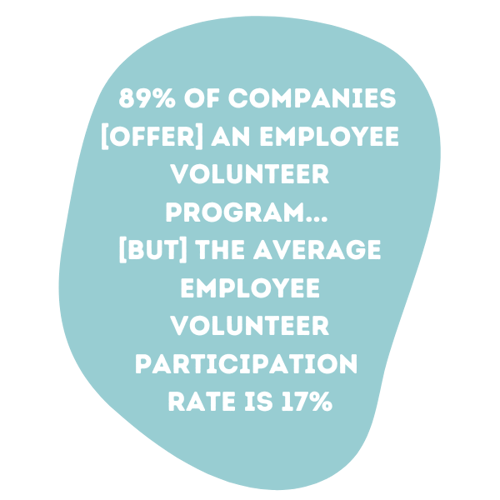
“Employer-sponsored volunteer programs are pretty widespread; it’s just that the uptake isn’t very high,” explains Sara Singer, a Stanford Business School professor who conducted research on the impact of employee volunteering.4
The surprise twist? Employees say they want to give back—and that they want their company to facilitate it. Seventy-one percent of employees say it is very important to work where the culture is supportive of giving and volunteering.5 Employees even find the presence of an employee volunteering program promising; they think it indicates that the company treats employees well and follows values similar to their own.6
In 2017, Deloitte conducted a survey to dig deeper into how American employees view volunteerism. The results were staggering. Of the 1,000 employees interviewed, 70% believed that volunteer opportunities boosted morale more than company mixers, 77% believed that volunteer activities are essential to employee well-being and 78% thought companies who sponsored volunteer activities created a better working environment than those who did not.7
Yet in the same survey, 69% of employees said they do not volunteer as much as they would like.8 This trend is evident in a larger capacity as well. Nearly 90% of all Americans want to volunteer, but only 25% actually do.9
According to Singer, this lack of participation is a huge missed opportunity for organizations, especially given her powerful findings: “Employees who volunteer have greater individual wellbeing and also higher levels of pro-employer outcomes such as engagement and job satisfaction.”10
A Powerful Missed Opportunity
Singer’s findings align with decades of research indicating that when employees give back, they experience incredible wellness benefits. In a newly distributed workforce, these benefits are “more important than ever,” according to Ashley Rhodes of Adobe, a leader in corporate responsibility: “People are looking for these outlets that allow them to feel connected and contribute something tangible to an important cause.”11 Company-wide CSR is one of the most effective ways to facilitate that. If executed well, it has the potential to improve employees’ health and wellness, sense of connection and, ultimately, retention and productivity.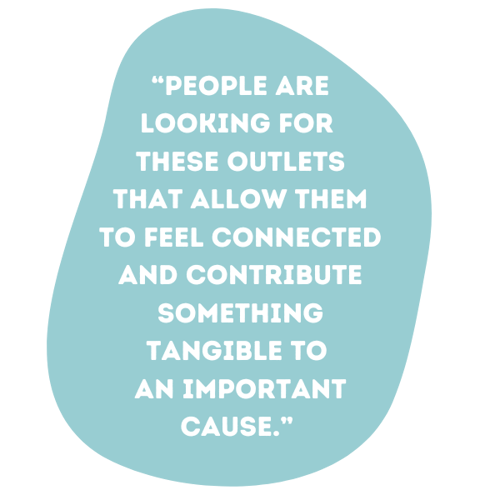
Improved Health & Wellness
Improved health and wellness is a leading benefit of giving back. In today’s workforce, where employee burnout and stress have hit record highs, this benefit is more valuable than ever. “U.S. workers are some of the most stressed employees in the world,” according to Gallup’s State of the Global Workplace report, with 62% of employees reporting high levels of stress with extreme fatigue and feeling out of control.12 These persistent levels of stress have organization-wide repercussions, including higher rates of attrition and absenteeism.13
Giving back can help break this cycle. Called a “cure for what ails you,”14 studies show that 75% of U.S. adults feel physically healthier after volunteering.15 This is not a placebo effect: Volunteering has been proven to lower blood pressure,16 reduce stress,17 anxiety and loneliness, and strengthen relationships.18 It can also improve the giver’s state of mind. Helping others causes the secretion of feel-good chemicals in the brain, like serotonin, dopamine, and oxytocin, often referred to as a helper’s high.19 After volunteering, 93% of people report being in a better mood and 88% report increased self-esteem.20 This results in fewer incidences of depression21 and greater satisfaction with their life.22 In short: volunteering truly makes people happier.
To quantify the impact giving back has on the giver’s happiness, researchers compared it to the effects of income. They found that for a participant earning a middle-class salary, volunteering would make someone as happy as having an extra $1,100.23
More Connected Employees
Another chief benefit of giving back is its ability to make employees feel more connected to their community, their company and their colleagues. For today’s companies, where only 25% of employees feel connected to their organization24 and only 31% are satisfied with the amount of connection they have with colleagues,25 this is a significant opportunity.
In a United Healthcare study, 81% of participants said that volunteering together strengthens relationships among colleagues.26 It also fosters a stronger sense of belonging at the organization,27 which leads to increased feelings of loyalty and pride.28 A study at Stanford called the employee volunteer effect “two-pronged magic,” because of how it simultaneously connects employees to each other and their employer.29
Jennifer Hartman, an HR expert with Fit Small Business, sums up how employee volunteering can revolutionize company culture. “By giving employees the opportunity to volunteer during company time, companies are able to build a sense of community and create a work environment that is supportive and friendly.” Hartman explains that this enhanced sense of community can ultimately “reduce cost and improve productivity” within a company.30
An Impressive Outcome: Higher Engagement, Retention and Productivity
The ripple effect of employee volunteering culminates with a direct influence on the company’s bottom line. This starts with its ability to strengthen work performance. “People who give time feel more capable, confident, and useful,” explains Wharton’s Cassie Mogilner. “They feel they’ve accomplished something and, therefore, that they can accomplish more in the future.”31 Volunteering experience can also play a role in building leadership skills critical to becoming a successful leader in the workplace.32
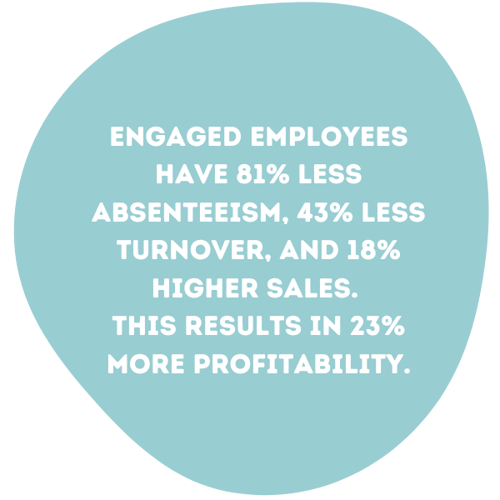
As Jessica Rodell writes in the Harvard Business Review, “The benefits of well-designed corporate volunteer programs have been clearly established: They boost productivity, increase employee engagement, and improve hiring and retention, to name just a few.” They’ve also been proven to enhance employee morale and workplace atmosphere33 and demonstrate organizational values in action,34 improving a company’s triple bottom line.35
Deloitte explored these outcomes in its Volunteer Impact Survey. The survey found that those who frequently volunteered had higher levels of engagement at work than those who rarely or never volunteered. This ultimately drove greater satisfaction, pride and loyalty at work and was “inextricably linked to organizational performance.”36
The impact is undeniable. Units with engaged employees have 81% less absenteeism, 43% less turnover, and 18% higher sales. This results in 23% more profitability.37 That’s a huge return on investment. So, why haven’t more companies been able to create programs that capitalize on this?
Where Giveback Programs Go Awry
Employees claim they want volunteer programs and companies are readily providing them—but the participation rate is startlingly low. This disconnect suggests that the issue lies with the programs themselves. If the conditions aren’t the right fit, companies lose the buy-in of even the most well-meaning employee.38
Employees cite several areas of friction that are common barriers to volunteering—most notably, volunteer opportunities that don’t feel meaningful enough.39 “Most people are motivated to volunteer by personal gratification and having a meaningful experience,” explains the Stanford Center for Longevity. If the mission doesn’t align with an employee’s interests and values, the chance of participation plunges.40
However, corporate volunteer programs often reflect the priorities of top management—which aren’t necessarily the same for employees.41 “Employee empowerment is key to getting a full ‘return’ on community involvement,” explains Fortune Magazine.42
Logistics are another common impediment to employee giveback. If volunteer opportunities are too time-consuming, don’t offer flexible scheduling43 or are not conveniently located,44 employees are less motivated to participate. Flexibility is paramount: the more the opportunity suits an employee’s location and schedule, the more inclined they are to participate. The solution, explains The Stanford Center for Longevity, is “to make volunteering more accessible and automatic…Employers could encourage volunteerism on-site or in a proximate location. Organizations could be more flexible in the way they use volunteer work, including work that could be done at home, or during evening or weekend hours.”45
Another simple but critical barrier to employee volunteering is a lack of knowledge regarding opportunities. One out of four Americans say they don’t volunteer simply because no one asked them to.46 For today’s busy employees, it’s easy to overlook volunteer opportunities if they aren’t pushed out by companies in a consistent and well-publicized manner.
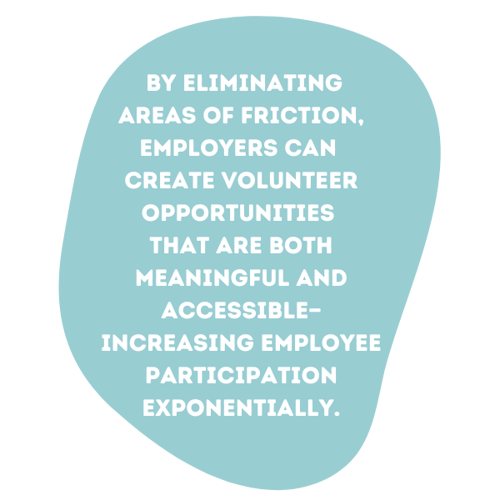
A distributed work environment has only exasperated these areas of friction. When colleagues aren’t physically in the same place, it becomes more challenging to plan and publicize company-wide CSR goals and opportunities that work for everyone. Remote employees can become disillusioned when opportunities cater to those working on-site and in-person employees can become frustrated if there aren’t enough local, hands-on opportunities. This can result in a lack of cohesion that diminishes employee participation and minimizes the ability to build community and connection through CSR.
The good news? According to Stanford’s Center for Longevity, “Potential for increasing volunteerism is high if we are able to address these common barriers.”47 By eliminating areas of friction, employers can create volunteer opportunities that are both meaningful and accessible—increasing employee participation exponentially. A digital giveback platform helps companies achieve that.
The Solution: A Digital Giveback Platform
A digital giveback platform offers curated and customizable CSR opportunities, so employees can choose causes they connect with in an environment that works for them. By eliminating potential areas of friction, the platform increases the likelihood of participation in company-wide CSR goals and programs.
Through an easy-to-use app, employees can control their logistics, customizing when and where they give back, whether they do it remotely or in person, and whether they participate alone or with colleagues, friends or family. Most importantly, they can identify the causes that are personally meaningful to them. This not only encourages participation, but also deepens the benefits they experience. By addressing a social problem that’s meaningful to them, employees build a sense of purpose, which further boosts their happiness.48
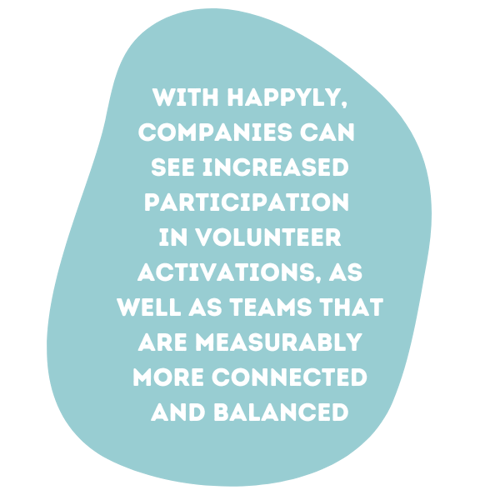
At the crux of a digital giveback platform is the ability to give employees the power of choice—something HR coach, Yamile Haibi, says employees find incredibly valuable. “Employees see freedom of choice on how to spend their volunteer hours, money and dedication as a benefit,” explained Haibi.49
A digital giveback platform also offers personalized support for employers. Leaders can submit parameters for company-wide CSR goals and opportunities and the platform will generate a custom giveback plan. In today’s distributed workforce, the platform takes into account both remote and in-person employees, creating options that are accessible to everyone. The platform can also help push the initiatives out internally in a consistent, organized manner, ensuring all employees are aware of available initiatives. By taking the onus of planning off of company leaders, the platform can cut organizational costs and manpower hours.
The result is a powerful chain reaction. CSR participation increases, which improves employee wellness, connection and engagement. This leads to higher levels of retention and productivity across an organization, ultimately improving profits. It’s a win-win for all—with just a few taps of an app.
Happyly Supports CSR Goals
Happyly is a digital wellness benefit with innovative scheduling tools and curated giveback opportunities, customizable for CSR initiatives. By bringing more meaning and accessibility to giving back, Happyly is changing the landscape of CSR. With the Happyly app, companies can see increased participation in volunteer activations, as well as teams that are measurably more connected and balanced.
Sources:
- Harvard Business Review: Volunteer Programs That Employees Can Get Excited About
- HR Morning: Why Corporate Volunteering Fails & What HR Can Do About It
- CECP: Giving in Numbers: 2022 Edition
- Insights by Stanford Business: Volunteering Encourages Employees to Connect with Each Other — and Their Jobs
- Source: America's Charities Snapshot Employee Donor Research
- Harvard Business Review: Volunteer Programs That Employees Can Get Excited About
- Deloitte Volunteer Impact Research
- Deloitte Volunteer Impact Research
- Creative Volunteer: 3 out of 4 Americans Won’t Volunteer: Here’s Why!
- Journal of Occupational and Environmental Medicine: Volunteering Improves Employee Health and Organizational Outcomes Through Bonding With Coworkers and Enhanced Identification With Employers
- Chief Executives for Corporate Purpose (CECP): How Adobe and Team4Tech Scaled Virtual Volunteering Experiences and Boosted Engagement
- The American Institute of Stress: Workplace Stress
- Pathways: HR’s Guide to the Effect of Job Stress on Employee Performance
- Charity Navigator: Selfless Self-Care: How to Improve Your Mental Health by Giving Back
- UnitedHealth Group 2017 Doing Good is Good for You Study
- Charity Navigator: Selfless Self-Care: How to Improve Your Mental Health by Giving Back
- Talk Space: What Giving Back Does For Your Mental Health
- Happiness.com: Why is Volunteering Important?
- Talk Space: What Giving Back Does For Your Mental Health
- UnitedHealth Group 2017 Doing Good is Good for You Study
- Talk Space: What Giving Back Does For Your Mental Health
- National Alliance on Mental Illness: How Volunteering Improves Mental Health
- Greater Good Magazine: How Volunteering Can Help Your Mental Health
- Gartner Podcast: Organization Culture and Connectedness is in Crisis
- Forbes: The Connection Crisis: Craving Friends at Work and How to Bring Back Belonging
- Monster.com: Paid time-off Volunteer Programs are a Win-Win
- Insights by Stanford Business: Volunteering Encourages Employees to Connect with Each Other — and Their Jobs
- Monster.com: Paid time-off Volunteer Programs are a Win-Win
- Insights by Stanford Business: Volunteering Encourages Employees to Connect with Each Other — and Their Jobs
- SHRM: Position Community Volunteering as an Employee Benefit
- Harvard Business Review: You’ll Feel Less Rushed if You Give Time Away
- Deloitte Volunteer Impact Research
- Business News Daily: Want a better workplace? Encourage employees to volunteer
- Points of Light Business 4 Better: Seven Practices of Effective Employee Volunteer Programs
- Galaxy: Corporate Volunteering: The Key to Increasing Your Company’s Impact
- 2011 Executive Summary Deloitte Volunteer IMPACT Survey (download from Deloitte)
- Gallup: The Right Culture: Not Just About Employee Satisfaction
- Insights by Stanford Business: Volunteering Encourages Employees to Connect with Each Other — and Their Jobs
- Harvard Business Review: Volunteer Programs That Employees Can Get Excited About
- University of Maryland Medical System: The Health Benefits of Volunteering
- Harvard Business Review: Volunteer Programs That Employees Can Get Excited About
- Giving Workers Paid Time off to Volunteer will Help Your Company Succeed
- Creative Volunteer: 3 out of 4 Americans Won’t Volunteer: Here’s Why!
- Stanford Center for Longevity: 3 Reasons Why People Don’t Volunteer and What Can be Done About It
- Stanford Center for Longevity: 3 Reasons Why People Don’t Volunteer and What Can be Done About It
- Stanford Center for Longevity: 3 Reasons Why People Don’t Volunteer and What Can be Done About It
- Stanford Center for Longevity: 3 Reasons Why People Don’t Volunteer and What Can be Done About It
- Happiness.com: Why is Volunteering Important?
- SHRM: Position Community Volunteering as an Employee Benefit
Get the PDF!
Want to share this report with your colleagues and peers? Download and print "The Employee Volunteer Discrepancy: How to Increase CSR Participation by Eliminating Areas of Friction" now.
